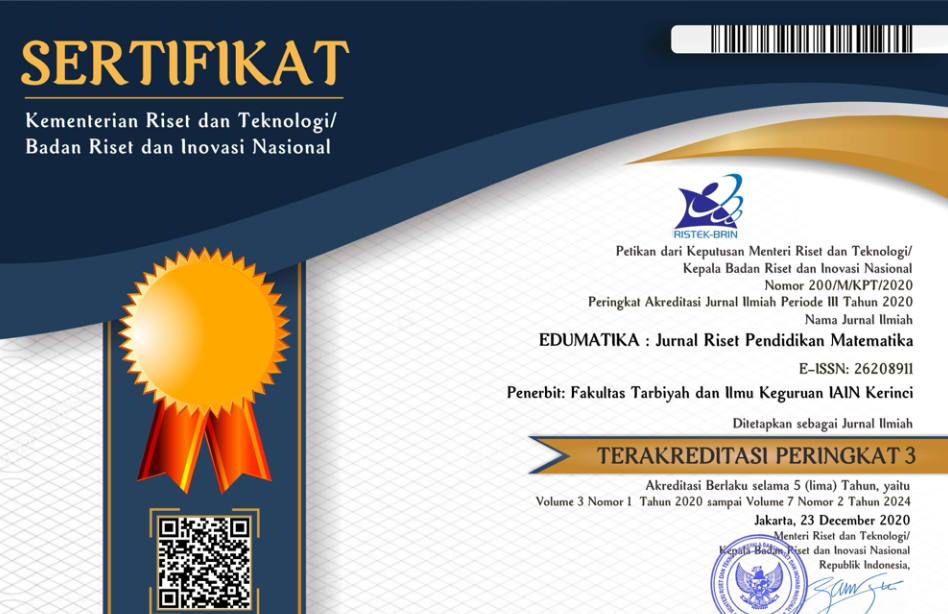Penerapan Model Pembelajaran Tuntas dengan Metode Tutor Sebaya untuk Meningkatkan Hasil Belajar Matematika Siswa SMP
Keywords:
Mastery learning model, Peer tutoring, Mathematics learning outcomes
Abstract This research is motivated by the low student mathematics learning outcomes. The reason is the lack of full delivery of lessons and students have not fully understood the material. One alternative to overcome this problem is to implement a complete learning model with peer tutoring methods. The purpose of this study: 1) to describe the improvement of students 'mathematics learning outcomes through the application of a complete learning model with material peer tutoring methods to construct flat-side space for junior high school students, 2) to describe students' responses to the application of the complete learning model with peer tutoring methods. classroom action research with quantitative and qualitative descriptive analysis. Research location in Tuban 7th Middle School. The subjects studied were students of class VIII E. The instruments used were learning outcome evaluation test sheets and student response questionnaires. The results of the study concluded that students' mathematics learning outcomes in the application of the complete learning model with peer tutoring methods had increased. This can be seen from the average student learning outcomes of the first cycle of 88, the second cycle of 89 and the third cycle of 97. So there is an increase in the average mathematics learning outcomes in the first cycle to the second cycle of 1 and from cycle II to cycle III amounting to 8. And the percentage of classical completeness in cycles I, II and III reach 100%. While the student response to the application of the complete learning model with peer tutors is included in the criteria very effective, with a percentage of positive responses of 96% and the percentage of negative responses of 4%.
Downloads
Download data is not yet available.
References
Ahdiyat, M. (2015). Metode Tutor Sebaya Untuk Meningkatkan Hasil Belajar Matematika Pada Materi Pengolahan Data. Faktor Jurnal Ilmiah Kependidikan, 1(2).
Anistyani, T. A., & Radia, E. H. (2018). Pengaruh Pembelajaran Tutor Sebaya Terhadap Hasil Belajar Matematika Kelas V Sekolah Dasar. Jurnal Karya Pendidikan Matematika, 5(1), 15-22.
Arikunto, S. 2013. Prosedur Penelitian Suatu Pendekatan Praktik. Jakarta: Rineka Cipta
Indrianie, N. S. 2015. Penerapan Model Tutor Sebaya pada Mata Pelajaran Bahasa Inggris Reported Speech terhadap Hasil Belajar Peserta Didik MAN Kota Probolinggo. Jurnal Kebijakan dan Pengembangan Pendidikan, 3(1).
Izzati, N. (2015). Pengaruh Penerapan Program Remedial dan Pengayaan Melalui Pembelajaran Tutor Sebaya Terhadap Hasil Belajar Matematika Siswa. Eduma: Mathematics Education Learning and Teaching, 4(1).
Julianingsih, D. (2018). Upaya Meningkatkan Prestasi Belajar Siswa Matematika Melalui Strategi Pembelajaran Tutor Sebaya Dalam Penguasaan Bangun Datar Kelas VI SD Hidayatur Rohman Surabaya. Edumatika: Jurnal Riset Pendidikan Matematika, 1(1), 22-34. doi:10.32939/ejrpm.v1i1.219
Majid, A. 2016. Strategi Pembelajaran. Bandung: PT Remaja Rosdakarya
Purba, H. 2013. Penerapan Model Pembelajaran Tuntas untuk Meningkatkan Hasil Belajar Siswa Pada Mata Pelajaran Matematika Di Kelas VIII-I SMPN 1 Merek. Jurnal Saintech 5(1), 31-38
Sinambela, E. E. (2015). Meningkatkan Hasil Belajar Aljabar Siswa Dengan Menggunakan Metode Tutor Sebaya di SMP Negeri 175 Jakarta. Formatif: Jurnal Ilmiah Pendidikan MIPA, 4(1).
Ulandari, N., Putri, R., Ningsih, F., & Putra, A. (2019). Efektivitas Model Pembelajaran Inquiry terhadap Kemampuan Berpikir Kreatif Siswa pada Materi Teorema Pythagoras. Jurnal Cendekia: Jurnal Pendidikan Matematika, 3(2), 227-237.
Anistyani, T. A., & Radia, E. H. (2018). Pengaruh Pembelajaran Tutor Sebaya Terhadap Hasil Belajar Matematika Kelas V Sekolah Dasar. Jurnal Karya Pendidikan Matematika, 5(1), 15-22.
Arikunto, S. 2013. Prosedur Penelitian Suatu Pendekatan Praktik. Jakarta: Rineka Cipta
Indrianie, N. S. 2015. Penerapan Model Tutor Sebaya pada Mata Pelajaran Bahasa Inggris Reported Speech terhadap Hasil Belajar Peserta Didik MAN Kota Probolinggo. Jurnal Kebijakan dan Pengembangan Pendidikan, 3(1).
Izzati, N. (2015). Pengaruh Penerapan Program Remedial dan Pengayaan Melalui Pembelajaran Tutor Sebaya Terhadap Hasil Belajar Matematika Siswa. Eduma: Mathematics Education Learning and Teaching, 4(1).
Julianingsih, D. (2018). Upaya Meningkatkan Prestasi Belajar Siswa Matematika Melalui Strategi Pembelajaran Tutor Sebaya Dalam Penguasaan Bangun Datar Kelas VI SD Hidayatur Rohman Surabaya. Edumatika: Jurnal Riset Pendidikan Matematika, 1(1), 22-34. doi:10.32939/ejrpm.v1i1.219
Majid, A. 2016. Strategi Pembelajaran. Bandung: PT Remaja Rosdakarya
Purba, H. 2013. Penerapan Model Pembelajaran Tuntas untuk Meningkatkan Hasil Belajar Siswa Pada Mata Pelajaran Matematika Di Kelas VIII-I SMPN 1 Merek. Jurnal Saintech 5(1), 31-38
Sinambela, E. E. (2015). Meningkatkan Hasil Belajar Aljabar Siswa Dengan Menggunakan Metode Tutor Sebaya di SMP Negeri 175 Jakarta. Formatif: Jurnal Ilmiah Pendidikan MIPA, 4(1).
Ulandari, N., Putri, R., Ningsih, F., & Putra, A. (2019). Efektivitas Model Pembelajaran Inquiry terhadap Kemampuan Berpikir Kreatif Siswa pada Materi Teorema Pythagoras. Jurnal Cendekia: Jurnal Pendidikan Matematika, 3(2), 227-237.
Published
2019-08-18
DIMENSIONS
How to Cite
Khotimah, K., & Yuliastuti, R. (2019). Penerapan Model Pembelajaran Tuntas dengan Metode Tutor Sebaya untuk Meningkatkan Hasil Belajar Matematika Siswa SMP. Edumatika : Jurnal Riset Pendidikan Matematika, 2(2), 77–82. https://doi.org/10.32939/ejrpm.v2i2.301
Section
All Spectrum of Mathematics Education (Unsorted)
















